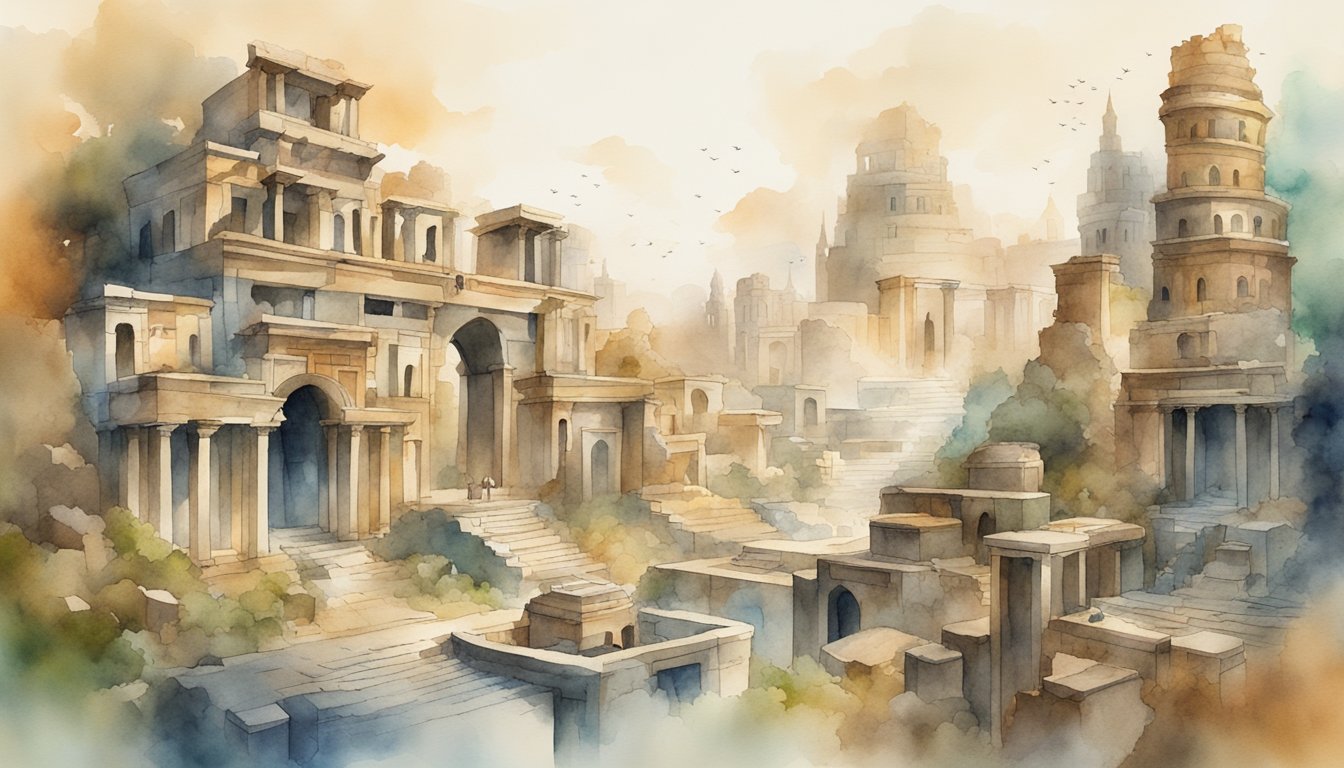Foundations of Early Civilization
The emergence of early civilizations marks a pivotal shift from nomadic societies to structured, urban life. Complex societies blossomed across different regions, each contributing unique advancements to the overall tapestry of human progress in areas such as agriculture, art, writing, and governance.
Mesopotamia: Cradle of Civilization
Mesopotamia, situated between the Tigris and Euphrates rivers in present-day Iraq, is often celebrated as the Cradle of Civilization. Here, the Sumerians established some of the first cities like Uruk and Ur, where they built impressive structures including the famed ziggurats, which served as temples. The Epic of Gilgamesh, an important piece of Sumerian literature, originated here.
Indus Valley: Early Urban Development
The Indus Valley Civilization, centered in what is now India and Pakistan, was notable for its sophisticated city planning and urban development. Cities like Harappa and Mohenjo-Daro featured advanced drainage systems and were well-organized, suggesting a high level of civic administration and a keen understanding of urban settlement needs.
Ancient Egypt: A Monumental Civilization
Ancient Egypt, thriving along the Nile River, was a civilization of grand scale and ambition, as evidenced by the construction of monumental pyramids and temples. Pharaohs ruled as living gods and were at the center of a culture deeply entwined with religion and art, and their legacies were embodied in stone.
The Influence of Art and Religion
In each of these civilizations, art and religion were deeply interconnected, with temples often adorned with intricate sculptures and reliefs depicting gods and deities. Religious beliefs were a driving force behind much of the visual culture, influencing everything from pottery design to the architectural layout of sacred spaces.
Advances in Agriculture and Trade
The development of agriculture, including the implementation of irrigation technologies, was a cornerstone that enabled these ancient societies to flourish. Surplus food production stimulated trade both within and between civilizations, allowing them to exchange goods as well as cultural and technological innovations.
Development of Writing and Education
The advent of writing systems like cuneiform in Mesopotamia and hieroglyphs in Egypt allowed for the documentation of knowledge and administration, paving the way for the first schools and organized educational systems. Scribes played a pivotal role in preserving and disseminating information across generations.
The Rise of Political Structures
With the increase in population, political structures emerged to manage and govern the complex social hierarchies of these civilizations. The Akkadian Empire, led by Sargon of Akkad, represents one of the first instances of empire-building in the ancient world. Laws such as those codified by Hammurabi in Babylon demonstrate the pursuit of order and justice within these evolving societies.
Cross-Cultural Connections and Technologies

The cradle of civilization witnessed a myriad of advancements and exchanges that shaped human progress. From the bustling trade networks to the spread of religious practices, early civilizations were far from insular entities, as they constantly learned from one another and shared knowledge across vast territories.
Trade Networks and Economic Growth
Trade networks were pivotal in promoting economic growth, as seen in the Bronze Age trade routes connecting Mesopotamia with the Indus Valley. These trade interactions facilitated not only the exchange of goods but also the transfer of technologies, such as metalworking techniques and the spread of the wheel, which revolutionized transport and warfare.
Technological Innovations and Their Impacts
Innovations such as the Sumerian invention of the wheel were fundamental to the advancement of civilizations, making trade and construction more efficient. The adoption of the chariot, for example, propelled military tactics and communication across empires like Persia and later influenced the strategies of Alexander the Great’s cavalry.
Cultural Exchanges and Legacy
Cultural exchanges left lasting legacies, bridging civilizations and enriching societies. The Epic of Gilgamesh, an ancient Mesopotamian poem, has transcended cultures, offering insights into human nature and societal norms. Such literature reflects deep cultural identity and the interchange of ideas through oral and written traditions.
Expansion and Influence of Empires
Empires expanded through conquest and diplomacy, influencing vast regions. Egypt’s unity under early dynastic leadership fundamentally shaped the Mediterranean’s political landscape, while language and philosophy were dispersed across the Persian Empire, leaving a tapestry of multicultural influences.
Architecture and Infrastructure Development
Architecture underscored the might and vision of civilizations. The pyramids of Egypt stand as testament to architectural skill and the organization of labor, while ziggurats in Sumer exhibit the confluence of religious and civic life. Infrastructure such as city drainage systems in the Indus Valley highlight the importance of urban development and public health.
Evolution of Social and Economic Systems
The development of cities brought about complex social and economic systems. Taxation, labor organization, and social stratification became integral components sustaining civilizations like Sumer and Indus Valley. These settlements instituted frameworks for commerce and governance that would shape future market economies.
Early Science, Mathematics, and Medicine
Advancements in early science, mathematics, and medicine were phenomenal. Egyptian and Mesopotamian civilizations contributed to the foundation of astronomy and the creation of some of the earliest calendar systems, while numerals and medical treatments reflected a growing understanding of the world and human health.
Arts and Literature as Reflections of Society
Arts and literature flourished as reflections of society, sharing stories, beliefs, and aesthetics. Artifacts from ancient times, from pottery to statues, depict not just artistic talent but a civilization’s daily life, rituals, and social hierarchy. They are windows into past cultures, revealing the dynamics and values of early societies.
Religious Beliefs and Practices
Religious beliefs and practices were central to early civilizations, often governing daily life and societal norms. Temples and religious texts from Mesopotamia to Egypt played crucial roles in establishing belief systems and rituals, with deities often personifying natural phenomena and guiding moral codes.

